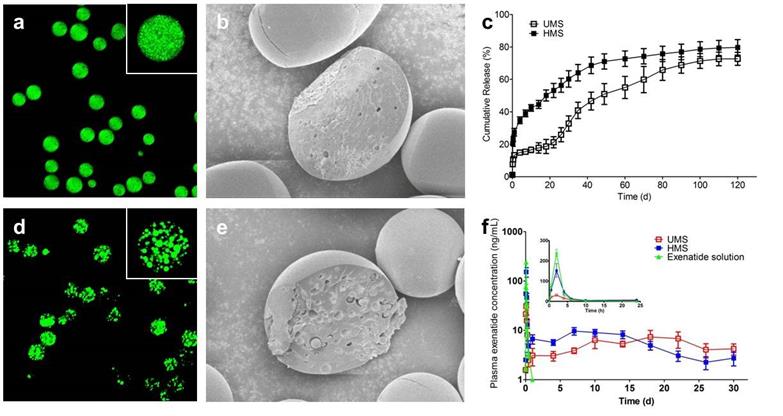
An Exhaustive Study on the Influence of Primary Emulsion Preparation on the PLGA Microspheres
Jul 11, 2014 Email"> PrintText Size

It is commonly known that primary emulsion (W1/O) preparation method (ultrasonication or homogenization) plays an important role on the properties of microspheres for long-term release, such as encapsulation efficiency, release behavior and pharmacodynamics. Although very limited researches have reported the discrepancy between ultrasonication and homogenization in the properties of microspheres, they only scratched the surface and the mechanisms have not been clarified in detail. It’s partly because that broad size distribution obtained by conventional preparation will impact on analysis and reliability of the mechanism.
Recently, the research team led by Prof. MA Guanghui at Institute of Process Engineering (IPE) of the Chinese Academy of Sciences, explored the exhaustive study on this discrepancy and helped to understand the mechanisms of release behavior, degradation and other aspects of microspheres deeply.
Based on Shirasu Porous Glass (SPG) premix membrane emulsification technique developed by the team, uniform-sized exenatide-loaded poly(DL-lactic-co-glycolic acid) (PLGA) microspheres were readily prepared. Comparative studies between microspheres whose W1/O was formed by ultrasonication (UMS) and by homogenization (HMS) were elaborately performed, including in vitro release, polymer degradation, morphological changes, microclimate pH (μpH), pharmacology and so forth. These comparative results provided us a semiquantitative relationship between primary emulsion preparation method and release period, which was instructional to achieve desired release period in the preparation of microspheres.
This study indicated a renewed sense and guidance of microsphere preparation in pharmaceutics. The results have been published onPharmaceutical Research, 2014, 31(6):1566-1574.

Figure (a) Confocal image and (b) SEM image of UMS; (c) in vitro release profile; (d) confocal image
(e) SEM image of HMS; (f) pharmacokinetics. (Image by IPE)
It is commonly known that primary emulsion (W1/O) preparation method (ultrasonication or homogenization) plays an important role on the properties of microspheres for long-term release, such as encapsulation efficiency, release behavior and pharmacodynamics. Although very limited researches have reported the discrepancy between ultrasonication and homogenization in the properties of microspheres, they only scratched the surface and the mechanisms have not been clarified in detail. It’s partly because that broad size distribution obtained by conventional preparation will impact on analysis and reliability of the mechanism.
Recently, the research team led by Prof. MA Guanghui at Institute of Process Engineering (IPE) of the Chinese Academy of Sciences, explored the exhaustive study on this discrepancy and helped to understand the mechanisms of release behavior, degradation and other aspects of microspheres deeply.
Based on Shirasu Porous Glass (SPG) premix membrane emulsification technique developed by the team, uniform-sized exenatide-loaded poly(DL-lactic-co-glycolic acid) (PLGA) microspheres were readily prepared. Comparative studies between microspheres whose W1/O was formed by ultrasonication (UMS) and by homogenization (HMS) were elaborately performed, including in vitro release, polymer degradation, morphological changes, microclimate pH (μpH), pharmacology and so forth. These comparative results provided us a semiquantitative relationship between primary emulsion preparation method and release period, which was instructional to achieve desired release period in the preparation of microspheres.
This study indicated a renewed sense and guidance of microsphere preparation in pharmaceutics. The results have been published onPharmaceutical Research, 2014, 31(6):1566-1574.

Figure (a) Confocal image and (b) SEM image of UMS; (c) in vitro release profile; (d) confocal image
(e) SEM image of HMS; (f) pharmacokinetics. (Image by IPE)
CAS Institutes
There are 124 Institutions directly under the CAS by the end of 2012, with 104 research institutes, five universities & supporting organizations, 12 management organizations that consist of the headquarters and branches, and three other units. Moreover, there are 25 legal entities affiliated and 22 CAS invested holding enterprisesThere are 124 I...>> more
Contact Us

Chinese Academy of Sciences
Add: 52 Sanlihe Rd., Xicheng District, Beijing, China
Postcode: 100864
Tel: 86-10-68597592 (day) 86-10-68597289 (night)
Fax: 86-10-68511095 (day) 86-10-68512458 (night)
E-mail: cas_en@cas.cn

